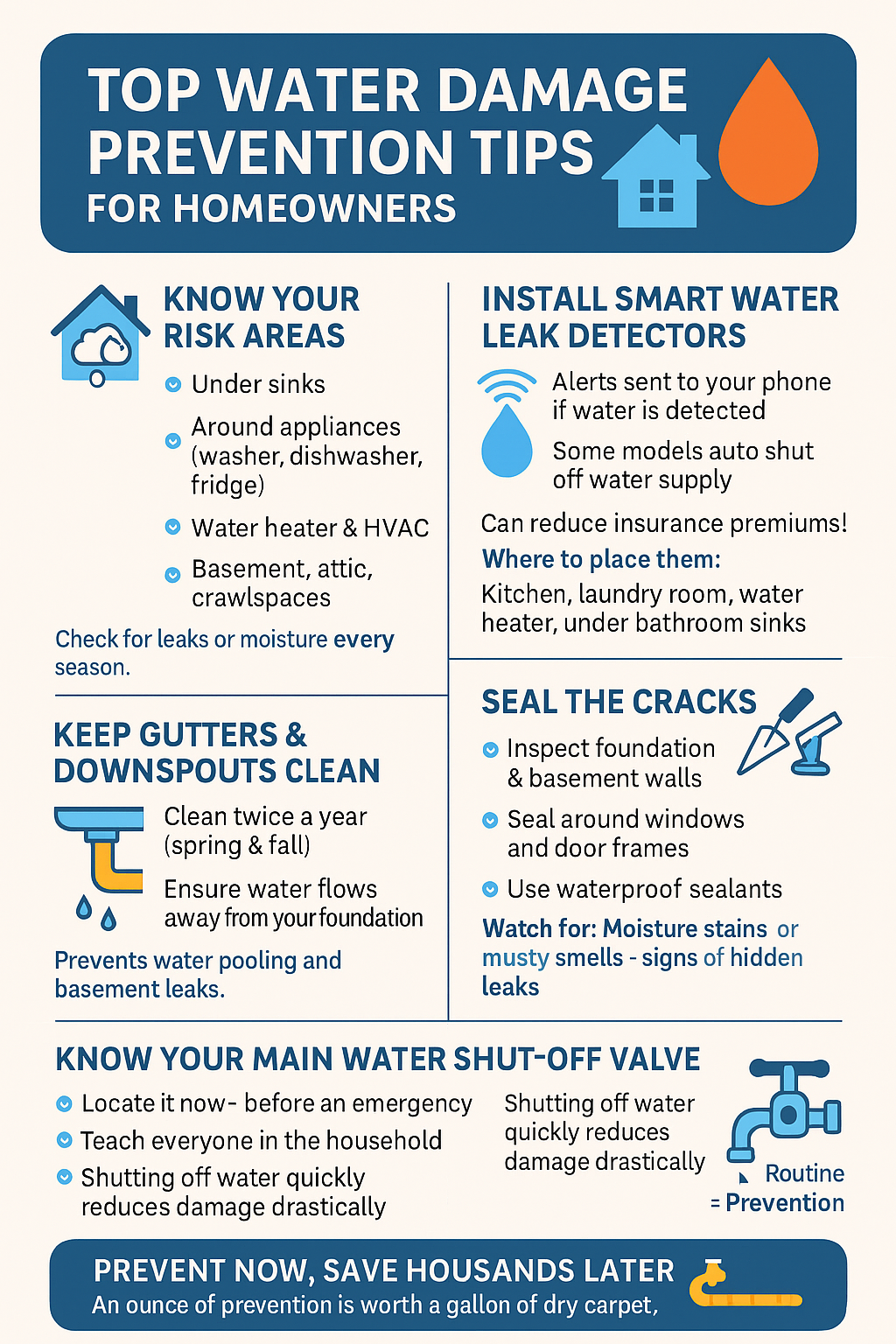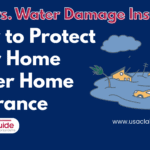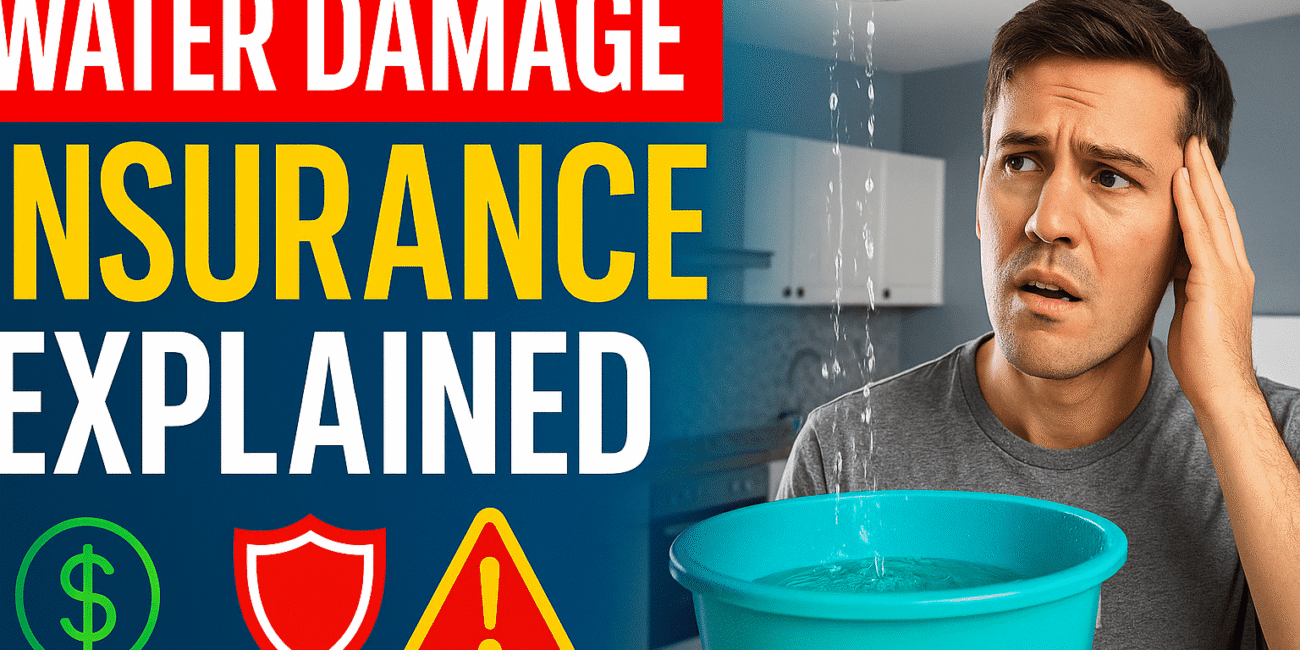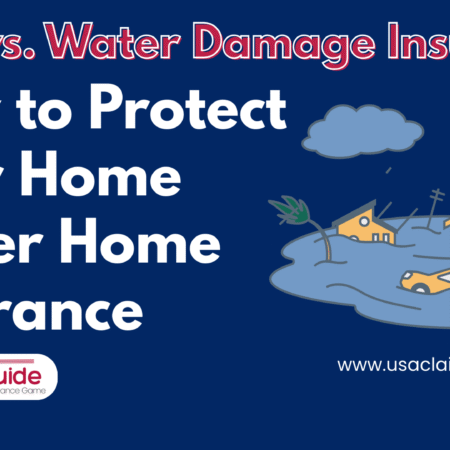Imagine this: You wake up one morning to the sound of water dripping but it’s not raining. You rush downstairs to find your kitchen floor soaked and water cascading from your ceiling. A burst pipe on the upper floor. Your heart sinks. The questions start racing: “Will my insurance cover this?” “How bad is the damage?” “What now?”
Water damage is one of the most common and stressful claims made on homeowners insurance in the U.S. If you’ve never experienced it, you’re lucky. But if you’re a homeowner, it’s not a matter of if, but when. And knowing how water damage insurance works could save you thousands.
Let’s dive deep (pun intended) into how water damage insurance works in the U.S., what it covers, what it doesn’t, and how you can protect your home, your sanity, and your wallet.
What Is Water Damage Insurance?
Water damage insurance is typically included in a standard homeowners policy, but with some major caveats. It helps cover the cost to repair damage caused by sudden and accidental water-related incidents.
For example:
- A pipe bursts due to freezing temperatures
- Your dishwasher overflows suddenly
- The HVAC system leaks into the ceiling overnight
These are usually covered. But insurance is very specific if the water damage is the result of poor maintenance or negligence, you could be out of luck.
A Quick Real-Life Story
A friend of mine in Ohio had a pipe burst during a freak cold snap. The damage to her wood flooring and drywall ran into the five-figure range. Thankfully, her insurance kicked in but only after they verified she had taken the proper steps to insulate her pipes. Had she ignored those preventive steps, her claim might have been denied.
Not All Water Is the Same At Least to Insurance Companies
Here’s the weird truth: insurance companies treat water differently depending on how it gets into your home. If it sprays out of a broken hose under your sink, that’s likely covered. But if it seeps in through your foundation after a heavy rainstorm, that’s usually considered flooding and standard policies don’t cover floods. You need separate flood insurance for that.
It’s like your insurance policy is okay with your house getting surprised by water, but not if it’s been warned. Sudden, unexpected = covered. Slow, neglected = not their problem.
What’s Typically Covered by Water Damage Insurance?
Let’s break it down. Most standard homeowners policies (HO-3 policies) cover:
- Sudden and accidental discharge of water (burst pipes, appliance failure)
- Damage to flooring, walls, ceilings, and belongings caused by the covered incident
- Mold remediation (if mold results from a covered water loss)
- Tear-out costs (i.e., removing a wall to fix a pipe)
This type of coverage can literally save your home. Water is sneaky it seeps into walls, warps flooring, and if left untreated, causes dangerous mold. Fixing this can cost anywhere from a few thousand to tens of thousands of dollars.
The Catch? Gradual Damage Isn’t Covered.
That means if your leaky toilet was slowly rotting your floorboards over months, your insurer may say, “Sorry, that’s wear and tear.” They expect you to be proactive and maintain your home.
Tip: Always check your policy. Some insurers require add-ons or endorsements to cover certain kinds of water damage like sewer backup or sump pump failure.
What’s NOT Covered by Standard Insurance?
This is where most people get blindsided. You assume “water damage” means any kind of water, right? Nope.
Here’s what’s usually excluded:
1. Flooding
Flooding from rivers, heavy rains, or hurricanes is not covered under standard homeowners insurance. For that, you need flood insurance, typically through FEMA’s National Flood Insurance Program (NFIP) or a private insurer.
A guy I met at a real estate seminar once shared how his ground-level home in Houston flooded during Hurricane Harvey. He didn’t have flood insurance. The damage? Over $80,000. The insurance payout? Zero. That event alone forced him into bankruptcy.
Lesson learned: If you live in a flood-prone area, get flood insurance. It’s not just “extra” it’s essential.
2. Negligence or Lack of Maintenance
If the insurance company finds out you ignored a known leak or failed to maintain your home (like not cleaning gutters, not fixing minor leaks), they can deny the claim.
3. Sewer Backup or Sump Pump Overflow
Unless you have a specific endorsement for this, your standard policy probably doesn’t cover it. Yet, this is one of the most common causes of water damage in basements. Check your policy and ask your insurer about adding this rider it usually costs under $100/year.
How to File a Water Damage Claim (The Right Way)
When disaster strikes, the way you handle your claim can mean the difference between full coverage and frustration. Here’s how to go about it:
1. Stop the Source and Prevent Further Damage
The first thing you must do is stop the leak and mitigate damage. Shut off the water supply, call a plumber if needed, and use fans or dehumidifiers to limit spread. If you don’t, insurers can deny your claim for negligence.
2. Document Everything
Take photos and videos of the damage before you start cleanup. Save receipts for emergency services, hotel stays, anything out-of-pocket.
3. Notify Your Insurance Company Immediately
Call your insurer as soon as possible. Delaying this can make your claim more complicated.
4. Get a Professional Assessment
In some cases, hiring a public adjuster (who works for you, not the insurer) can help you get a fair settlement. This is especially useful in larger claims, where disputes over mold or tear-out costs often arise.
Personal Tip:
Last year, my cousin in Florida dealt with a washing machine hose that burst while they were out of town. They returned to warped floors and waterlogged furniture. They filed a claim quickly, documented everything, and received a $22,000 payout. The whole process took about three weeks stressful, but smooth because they acted fast and followed the process.

Water Damage Prevention Tips: Because No One Wants to Swim in Their Living Room
If you’ve ever dealt with water damage, you know it’s not just about soggy carpets or warped wood. It’s the mess, the stress, the unexpected costs, and the battle with insurance adjusters who may or may not be in the mood to help that day.
So, if you’re lucky enough to be reading this before a major leak or flood, trust me when I say: prevention is your best friend.
1. Get to Know Your Home’s “Water Weak Spots”
Every house has them. The sneaky little areas where a minor issue can become a major disaster.
Start with these:
- Under the kitchen sink – Check for signs of slow leaks or mold. Even a tiny drip can lead to big problems over time.
- Washing machine hoses – These rubber hoses are notorious for bursting. If they’re older than 5 years, replace them with braided stainless steel hoses.
- Water heater – Is it aging like fine wine, or just… aging? Most water heaters have a lifespan of 8-12 years. Once they pass that, they’re ticking time bombs.
- Attics and crawlspaces – Out of sight, out of mind until your ceiling caves in. Check for water stains, condensation, or signs of mold.
I once had a pinhole leak behind my fridge that slowly warped my hardwood floor. I didn’t even notice it until my toddler splashed in the water like it was a puddle on a rainy day. That little leak cost me $4,000 in repairs. Lesson learned: even the tiniest drip deserves your full attention.
2. Invest in Smart Water Leak Detectors (They’re Not Just for Tech Nerds)
We live in a world where your thermostat can talk to your phone why not your plumbing?
Smart water leak detectors are game changers. You place them under sinks, behind appliances, or in the basement. If they sense moisture, they send an alert to your phone instantly.
Some even come with automatic shut-off valves that cut the water supply the moment a leak is detected. That’s like having a 24/7 plumber on duty minus the hourly rate.
These gadgets can cost anywhere from $50 to $200, but they’ve saved homeowners tens of thousands in damage. Plus, many insurers offer discounts on premiums if you install them. (Call your agent and ask it never hurts.)
3. Keep Your Gutters and Downspouts Clean and Happy
Gutters might not seem glamorous, but they’re your home’s first line of defense against water intrusion. Clogged gutters can cause water to overflow and seep into your foundation or basement.
Every fall and spring, grab a ladder (safely!) and clean them out. Or, better yet, install gutter guards. Also, make sure your downspouts are directing water at least 5-6 feet away from your home. Otherwise, you’re just inviting water to sneak in.
I had a neighbor who skipped gutter cleaning one year. A heavy rainstorm later, they found water creeping through their basement drywall. The culprit? Overflowing gutters spilling water right next to the foundation. A $300 cleanup bill turned into a $7,000 waterproofing job. Ouch.
4. Seal the Cracks Before Water Finds Them
If you have a basement, check for cracks in the foundation or around windows. Water loves to find the tiniest openings and sneak its way in.
Use waterproof sealant on visible cracks, and if you notice moisture on your basement walls, consider applying a waterproof coating or calling a specialist.
Pro tip: During a heavy rain, do a walk-around of your home. Are there puddles forming next to the foundation? Are your window wells collecting water? These are signs your drainage setup needs a little love.
5. Know Where Your Main Water Shut-Off Valve Is (and Teach Your Family)
In a water emergency, every second counts. The longer water flows, the worse the damage gets.
Make sure you know exactly where the main water shut-off valve is and how to use it. If you’re not sure, ask a plumber to show you. And don’t just keep that knowledge to yourself teach everyone in the house (yes, even the kids if they’re old enough).
A friend of mine left his teenage son home alone for a weekend. The toilet in the guest bathroom overflowed and wouldn’t stop. The poor kid didn’t know how to shut off the water and ended up soaking half the downstairs before help arrived.
Now, they have a laminated “What to Do in a Leak” guide taped to the inside of a kitchen cabinet. Smart move.
Real-World Case Study: What Happens Without Insurance
Let’s take a true story from New Jersey. In 2022, a family experienced a roof leak that damaged their attic insulation, ceiling, and part of their living room. Their insurer denied the claim, citing “ongoing leak not reported promptly.”
They didn’t have additional water damage riders, nor had they done regular inspections. The out-of-pocket cost? $17,500.
Contrast that with another homeowner in the same neighborhood who had a similar issue but had done annual maintenance checks and added a water backup rider. Their entire $19,000 repair bill was covered.
Conclusion: Don’t Let Water Wreck Your Wallet
Water can be calm and beautiful… until it’s not. A seemingly small leak can become a full-blown financial disaster if you’re unprepared. That’s why understanding your water damage insurance coverage is not just smart it’s essential.
Here’s your takeaway:
✅ Review your current policy
✅ Understand what’s covered and what’s not
✅ Consider add-ons like sewer backup and flood insurance
✅ Take preventative steps now before the damage
✅ File smartly if you ever need to claim
Call to action: Go check your policy tonight. Seriously. Make sure you’re not assuming you’re covered when you’re not. A five-minute check today could save you $15,000 tomorrow.
Have a story about water damage? Drop it in the comments. Let’s learn from each other.










